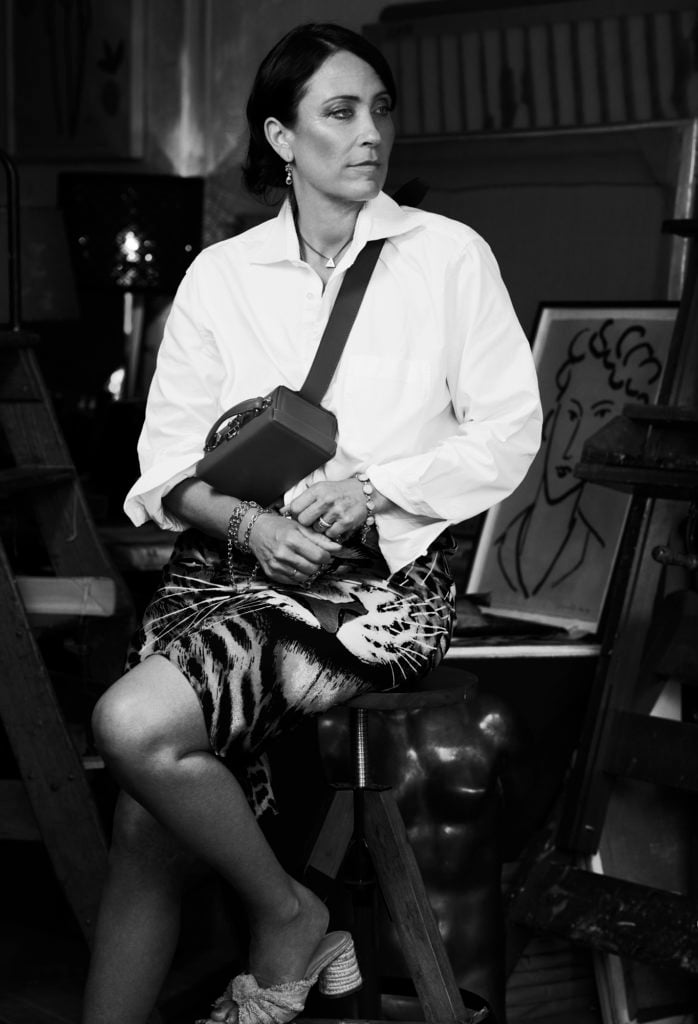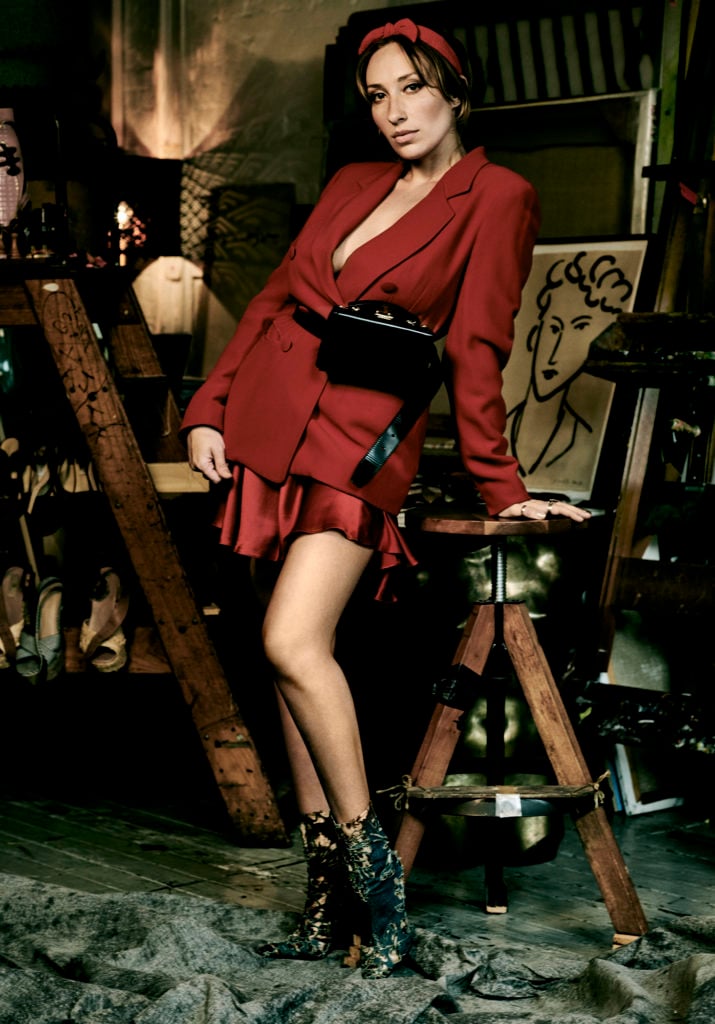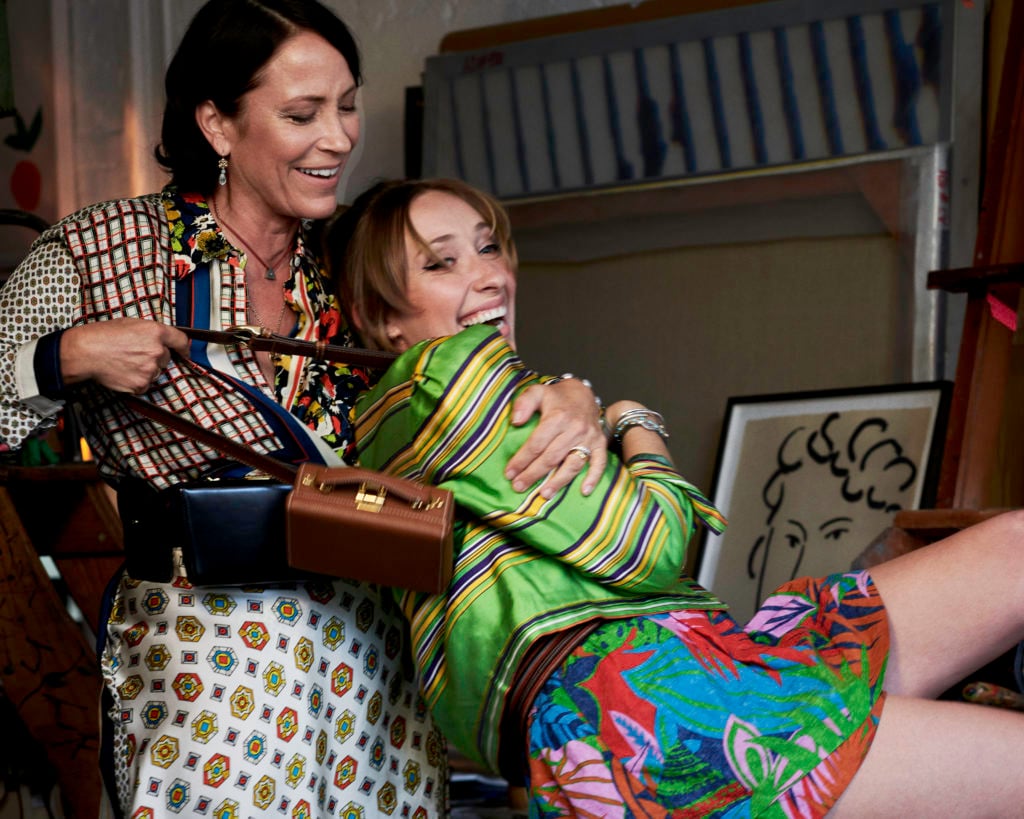“From One Woman to Another,” a five-part series co-produced by artnet News and Mark Cross, features intimate, candid conversations between eminent women at the pinnacle of the art industry and a mentor or protégé of their choosing, paired with original photography by David Lipman.
In the final installment of the series, artnet News contributor Maria Vogel interviewed artist Sophie Matisse and her daughter, the fashion designer Gaïa Jacquet-Matisse.
Painter Sophie Matisse—the granddaughter of the towering Modernist Henri Matisse and step-granddaughter of pioneering Dadaist Marcel Duchamp—has a bond with her daughter, Gaïa, that defies the typical mother-daughter relationship. Not only do they share the weight of great expectations, considering their lineage; they also have chosen careers that speak to their shared belief in staying true to themselves, which affords them a special kind of bond.
Though different in their demeanors and individual pursuits, they are self-described best friends—and, more than that, Sophie considers her daughter to be a mentor, and her closest confidante.
We spoke to the two about the special nature of their unwavering support of one another, how they have seen the art world change, and how they would advise young women entering the culture industry.
Tell me a bit about your backgrounds. How did you both fall in love with art? Do you remember the moment you connected with art significantly for the first time?
Sophie Matisse: Needless to say, I have a family that’s submerged in the art realm. While I grew up with that, I was kind of sheltered from it too. My father wasn’t a huge fan of making it a big deal. He had to grow up with it—he was closer to the fire, so to speak. So I kind of had a protected childhood, which I feel blessed to have had.
As a child, I had learning issues that I think can be attributed to a speck of dyslexia. Because of that, I realized anything that was expressed in an art form was much more fluid and natural for me. It was a language I stuck to because it was so convenient.
Gaïa Jacquet-Matisse: With my mother’s entire side of the family being artists, and my parents being painters, I was immersed in the art world from a very young age. I remember whenever we would go to galleries and museums, I would always run to the first bench I spotted, because I knew we were going to be there for a while.
I think because I had front-row access to the art world since day one, it definitely took me a little while to truly connect with art significantly. For me, it wasn’t until I began my first artistic explorations through acting at 16 that I began to really engage with art. Afterward, I remember going to a small Matisse exhibit at the Jewish Museum in New York, and the paintings moved me in a way that I had never felt before. Each brushstroke was so powerful, and I finally felt a connection.
Sophie, it’s interesting that you described Gaïa as your mentor for this project, instead of your protégé. How would you describe your relationship? What have you learned from each other over the years?
Matisse: Gaïa is so different from me, but we have a lot of similarities, too. I love her freedom and audacity. She’s unafraid and ready to go out there and conquer, and has been like that ever since she was a kid. I have a lot of admiration for that, and it’s something I’m much slower at doing myself. In certain situations, I ask myself, “How would Gaïa respond to this?”
We both have different elements that we bring to the conversation. I have more experience, but she has a depth of thinking that, in my opinion, is very developed. We’re always in touch, and we’ve always been very tight because her dad [Alain Jacquet] was very busy as an artist, always traveling and spending a lot of time in Paris. It left us together, just the two of us, much of the time. We are very tight, still; she could even be a sister in some ways. There’s a particular closeness there that’s not always what you get with kids. But, at the same time, she always felt free to go out and face the world.
Jacquet-Matisse: My mom and I have always been super close. She’s right, it was always the two of us, with my dad being a bit older and living between Paris and New York. She’s always been my best friend—and, I think because of how young she is at heart, we were always able to have fun and the best time together in virtually every situation. I feel so lucky to have been raised by artist parents who were so openminded. I was never pushed into doing something I didn’t like, and had the freedom to explore whatever I wanted.

Sophie Matisse. Photo by David Lipman.
What are your driving forces as women in the art world?
Matisse: It’s important to mention that I really was very inspired by my dad. He’s not in the art world—he’s a private artist and inventor, but he wasn’t involved in the art scene, per se. He was always making things and making things possible, and it gave me such an incredible feeling of empowerment in the sense that whatever I wanted to do was never out of the question. Anything felt possible.
After my dad, my other major influences would be Marcel and [Henri] Matisse—you can’t escape it! If Matisse felt a little heavy-handed, Marcel served as a lightweight, cheerful person to think about. Growing up with my grandmother, who carried and channeled his spirit, was a beautiful experience on a simple and pure level. That was a real blessing, and it gave me permission to stick to art that was close to the heart. Of course, Matisse is always there, like something that is still beating, always alive.
Jacquet-Matisse: My family is a huge inspiration for me. There are so many artists in it, and the way they work with so many different media is really fascinating. I’m also inspired by tribal artists from all around the world, and by ancient crafts and objects. It’s so beautiful to see what global artisans and cultures have been producing for thousands of years. They have unique senses of color and texture.
Tell me more about your individual artistic pursuits. What are you working on now?
Matisse: I’ve been creating stop-motion art films. They contain little storylines with chess pieces as characters, almost. There are no words, but little moments where there’s an actual emotional feeling between two pieces. I think it’s interesting and beautiful, in terms of timing and movement. It’s quite fun to do—a tedious thing, but very rewarding.
Jacquet-Matisse: I never really got into the arts, aside from acting, but I’d say my primary form of artistic expression is fashion. In the past year, I’ve created my own accessory line, AïA. I play with different textures to create unique, one-of-a kind pieces that celebrate the female form. I really love creating and playing with color.
Aside from AïA, I also work as a stylist, wardrobe consultant, and personal shopper, which allows me to play with fashion even more and help people feel more comfortable with themselves. How we dress is an outer form of representation of the self, and even though some would certainly say it’s on the superficial side of things, when you feel good in what you wear, it affects the energy you put out into the world. Some people have a harder time finding clothing they feel good in, and I love helping them with that.
How do you feel about the idea of striking a work/life balance?
Matisse: I feel like I just stepped out of that mode of feeling that I had to be “on it” all the time. The pressure from the art world is too distracting; my life is busy as it is.
These days, I choose which openings I attend and how I spend my time more carefully. Art is all around me all the time, and I’m constantly looking at things that show up in what I do. It’s important to not get too sucked into it—to stay grounded and aware of what’s meaningful to you, what actually makes a difference in your life. Sometimes that can get a little cloudy. It’s important not to let the outside world assume too much control, and to maintain a connection with your inner self.
Jacquet-Matisse: I think it’s very important to have a work/life balance. Because I don’t have a nine-to-five job, I have a lot of freedom to decide how I spend my time. When I don’t work for a long period, I feel frustrated, and that affects my personal life. The same goes for when I work too hard during shorter periods of time—it becomes exhausting. It’s all about finding a rhythm that works for you, and making sure that what you’re working on has some relation to what you love doing in life.

Gaïa Jacquet-Matisse. Photo by David Lipman.
What do you hope to see changed in the art world 10 years from now?
Matisse: It’s disheartening that some people are drawn to price tags instead of the art itself. That’s a shame. Sometimes you see artworks that go for astronomical prices that don’t make sense, and sometimes you see something that’s really great sell for a tenth of that price. On the other hand, the money issue has also brought art into a bigger realm, with more opportunities for artists all over the world, which is extremely important. We can learn a tremendous amount from other cultures, and that’s wonderful. I hope that the art industry continues to become more and more open, dissolving borders and just letting art and artists exist.
Jacquet-Matisse: Although I am not personally very involved in the art industry, I have seen how things have changed in the past 20 years. With the internet and social media, certain artists have risen to the top very fast, sometimes simply by doing what they know will sell. I hope in 10 years we can go back to the authenticity of the art world of earlier times, before social media and the idea that likes on Instagram equate to someone’s worth.
What advice would you give young women who are hoping to have careers in the art industry?
Matisse: The most rewarding thing is to make art that resonates with oneself. If you can afford to make art that speaks to your heart, it’s far more interesting and rewarding than any financial thing. There’s fantastic work being done, and you can tell when it’s from the heart. Stick to what resonates within you as much as possible, because it’s a losing battle if you don’t.
Jacquet-Matisse: I agree. The most important thing when creating art is to do it for yourself, and to stay true to yourself. When you start making something in order to please an audience, it becomes something completely different.
Photographer: David Lipman
Art Director: Yulu Serao
Stylist: Melena Lipman
Hair Stylist: Rudy Martins
Makeup: Tina Bech








